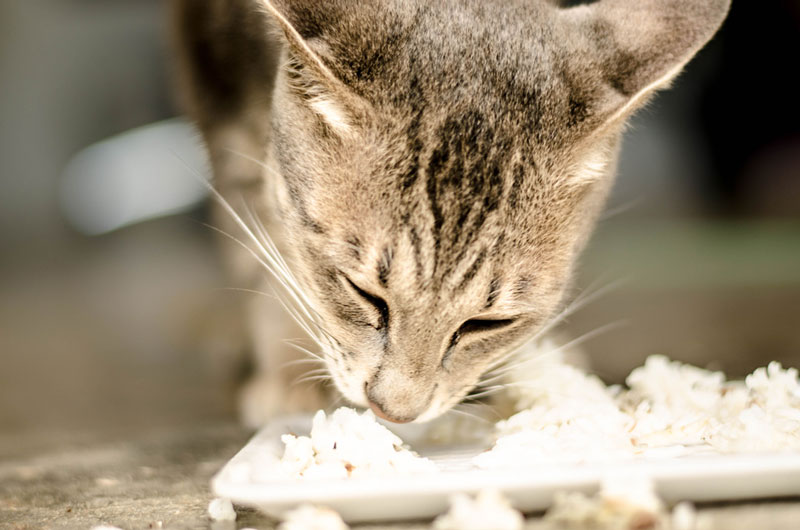Can cats eat rice? This is a question many cat owners have likely pondered at one point or another. The short and sweet answer is yes, cats can eat rice. However, it’s not a necessary part of their diet. Cats are obligate carnivores, meaning their primary nutritional needs are met through a meat-based diet. Although rice is not harmful in small quantities, it should only be offered as an occasional treat rather than a staple food item in your feline’s meals.
Now, while rice may seem harmless and might even be appealing to our furry friends during meal prep or mealtimes, it’s essential to keep in mind that rice lacks many vital nutrients that cats require. Think of rice as a snack or side dish rather than the centerpiece of their gourmet meal. So, if you’re curious about how to incorporate rice into your cat’s diet or what other options might be better suited, keep reading. We’ll explore everything you need to know about cats and rice, including benefits, risks, and substitutes!
As we journey through this topic together, let’s uncover the ins and outs of rice for our furry companions. Whether you’re a devoted cat owner or simply love exploring pet-related tidbits, you’re in the right place. Stay tuned as we unravel all your burning questions about cats and rice.
Can Cats Eat Rice?

As mentioned earlier, cats can indeed eat rice, but that doesn’t imply it should be a regular part of their diet. A cat’s digestive system is finely tuned to break down and process the nutrients found primarily in meat. Since they don’t naturally consume grains in the wild, rice holds no necessity in their meals. However, it can be a gentle addition during certain circumstances. For example, rice might serve as a convenient way to help settle a cat’s stomach during digestive distress or after a bout of vomiting or diarrhea. The blandness of rice can offer a soothing effect for cats experiencing mild tummy troubles.
Rounding up our understanding, serving rice occasionally and in moderate amounts is key. We should always ensure that it is cooked (because raw rice could potentially cause problems) and plain, without any added spices, sauces, or seasonings. Introducing rice into your cat’s diet should be done gradually to monitor for any allergic reactions or digestive issues. It’s important to remember that while rice may provide some energy as a carbohydrate source, our cats primarily need fatty acids, proteins, vitamins, and minerals that are best found in their natural diets. Remember to consult with your veterinarian before making any significant changes to your cat’s diet!
How Much Rice Can Cats Eat?
When considering how much rice to offer our feline friends, it is crucial to keep moderation in mind. Since rice doesn’t provide the essential nutrients our cats thrive on, it is best viewed as a rare treat rather than a meal replacement. A few tablespoons of cooked rice should suffice for an adult cat. To ensure it doesn’t cause gastrointestinal upset, start with a small amount and observe your cat’s reaction. If everything goes smoothly with their tummy, you can gradually increase the portions but maintaining at most a couple of tablespoons occasionally is ideal.
For kittens, the same rules apply, but be even more cautious. Their digestive systems are still developing, so introducing any new food should be done slowly and safely. It’s wise to consult your veterinarian about the best approach. Cats who are also overweight may need even stricter limitations, especially considering that rice could lead them to consume more calories than needed.
Now let’s not forget about the preparation of rice. Plain, boiled rice is the only safe option! Avoid adding anything to it, as seasonings and sauces can be harmful to your cat. It’s best to cook rice thoroughly and serve it cool, as this ensures the cat doesn’t accidentally burn their mouth. Also, avoid serving leftover rice from our own meals, as human food can contain additives or spices that might be harmful to a cat’s health.
In summary, while cats can eat rice and it can be beneficial for specific situations, moderation is key. It should never replace the core of their diet, which is best derived from animal proteins. Monitoring how much rice is served while keeping an eye on your feline’s general health and well-being is essential.
Benefits Of Rice To Cats
1. Digestive Aid: One of the substantial benefits of feeding rice to cats is its potential for soothing an upset stomach. When a cat is experiencing gastrointestinal distress, cooked rice can provide some relief, acting as a gentle binding agent that can help normalize their stool.
2. Energy Source: Rice is a source of carbohydrates, and while cats primarily need proteins, carbohydrates can still offer energy. In some cases, if our feline friend is a bit under the weather or needs extra calories, rice can temporarily act as a helpful supplement to their diet.
3. Palatability: For some cats, mixing a bit of rice with their regular food might make meals more exciting. The change in texture and flavor could entice picky eaters to enjoy their food more, especially if their interest in normal meals begins to dwindle.
4. Backup Food Option: In situations where we run out of cat food or need to make an emergency trip to the vet, having rice on hand can provide a short-term backup option. It’s a convenient food source that does not spoil quickly, and we can easily store it in our pantry.
5. Weight Maintenance: For overweight or less active cats, a small portion of rice can fill their bellies without packing too many calories. Cutting down on meat isn’t always a solution since cats require it; rice can add volume and a bit of satiety without overdoing it.
Dangers Of Feeding Rice To Cats
While rice can have some benefits, we must be cautious about potential risks and dangers associated with feeding it to cats. One of the primary concerns is heavy reliance on rice as a staple in their diets; since cats are obligate carnivores, their main source of nutrition should come from protein.
Another risk comes if cats have chronic diarrhea or other gastrointestinal problems. Rice may not always be the best solution for these conditions, and it could mask underlying health issues. Consulting with our veterinarian is essential before making rice a part of our cat’s diet because they can provide appropriate dietary recommendations.
There’s also the risk of overfeeding rice. Cats should not consume large amounts of carbohydrates, and rice should never replace the essential proteins found in their natural diets. Feeding too much rice could lead to obesity, diabetes, or other health issues associated with excess sugar and carbohydrate intake.
Finally, we shouldn’t forget about potential allergies. Like humans, cats can develop food allergies, and introducing new food should always be done with care. If our furry friends exhibit unusual behavior or signs of allergies after consuming rice—such as itching, gastrointestinal upset, or difficulty breathing—we must seek immediate veterinary attention.
Substitute Of Rice For Cats
1. Cooked Lean Meat: Since cats are primarily carnivores, cooked chicken, turkey, or fish provides essential protein while offering a nutritious treat that is much more suited to their dietary needs than rice.
2. Pumpkin Puree: Canned pumpkin (not the spiced kind, just pure pumpkin) can aid digestion and is high in fiber. This can be a great alternative to rice that offers more vitamins and minerals while promoting good overall health.
3. Sweet Potatoes: Cooked sweet potatoes are safe and can provide plenty of vitamins. They offer a similar texture to rice while being much healthier, making them a great rice alternative in small portions.
4. Peas: Mashed peas can be a tasty option for our kitties. They’re rich in protein and fiber and can help with digestion as well, serving as a great side dish for their regular meals.
5. Cat-Specific Alternatives: There are also cat food options available that contain rice and other grains formulated for feline diets available in pet stores. These options offer a more balanced approach with nutrients tailored to a cat’s dietary needs.
Can Cats Eat Rice? Frequently Asked Questions
Can All Cats Eat Rice?
Most cats can safely eat rice in moderation. However, individuals with specific health concerns should be evaluated by a veterinarian to ensure rice is appropriate for their diet.
Is Rice Safe In Any Form?
Plain, cooked rice is safe; however, raw rice, seasoned rice, or rice cooked with onion or garlic can be harmful to cats.
What If My Cat Doesn’t Like Rice?
Not all cats will take to rice, which is perfectly okay! It should not be forced into their diet. There are plenty of other healthy food options and treats that can be offered instead.
Can Rice Help With Cat Diarrhea?
Rice can sometimes help settle a cat’s stomach, but chronic diarrhea should be checked by a vet to identify any underlying health issues.
How Often Can I Offer Rice To My Cat?
Offering rice a couple of times a month is generally safe, ensuring that it doesn’t surpass the proportion of their regular meat-based diet.
Final Thoughts
In wrapping things up, we’ve explored quite a bit about cats and rice. Rice can be a helpful addition to our cat’s diet when approached with caution, but it has its risks and should not replace their main food source of protein. Understanding how much to feed and recognizing the potential benefits and dangers is essential in ensuring the health and happiness of our furry companions.
Whether you consider experimenting with rice for your kitty or prefer to stick with traditional cat food, we encourage you to remain engaged in their nutrition and overall health. For further reading on related topics, check out our articles on pet care tips, or discover what to do if you’re wondering can cats eat chocolate? and ponder over what foods dogs can have!


